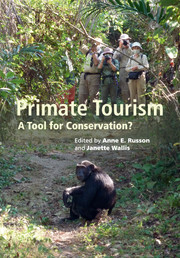Book contents
- Frontmatter
- Contents
- List of contributors
- Part I Introduction
- Part II Asian primates
- 2 Tourism, infant mortality, and stress indicators among Tibetan macaques at Huangshan, China
- 3 Provisioning and tourism in free-ranging Japanese macaques
- 4 Proboscis monkey tourism
- 5 Orangutan tourism and conservation
- 6 The impact of tourism on the behavior of rehabilitated orangutans (Pongo abelii) in Bukit Lawang, North Sumatra, Indonesia
- Part III African primates
- Part IV Neotropical primates
- Part V Broader issues
- Part VI Conclusion
- Index
- References
5 - Orangutan tourism and conservation
35 years’ experience
from Part II - Asian primates
Published online by Cambridge University Press: 05 September 2014
- Frontmatter
- Contents
- List of contributors
- Part I Introduction
- Part II Asian primates
- 2 Tourism, infant mortality, and stress indicators among Tibetan macaques at Huangshan, China
- 3 Provisioning and tourism in free-ranging Japanese macaques
- 4 Proboscis monkey tourism
- 5 Orangutan tourism and conservation
- 6 The impact of tourism on the behavior of rehabilitated orangutans (Pongo abelii) in Bukit Lawang, North Sumatra, Indonesia
- Part III African primates
- Part IV Neotropical primates
- Part V Broader issues
- Part VI Conclusion
- Index
- References
Summary
Introduction
Orangutan tourism has operated continuously since the 1970s, on both islands that orangutans inhabit (Borneo and Sumatra) and in both countries that govern them (Indonesia and Malaysia). As such it offers a rich example of primate tourism and an important one for conservation, especially from the long-term perspective (Butler, 1980; Catlin et al., 2011; Duffus & Dearden, 1990). Both Bornean and Sumatran orangutans are endangered, like all the great apes, and protected internationally from trade for commercial purposes (CITES, 2012, Appendix I; IUCN, 2011). Since the 1970s, conservationists have promoted great ape tourism as a lucrative and effective strategy for securing their survival (GRASP, 2005; Litchfield, 2001; Woodford et al., 2002) – close-contact tourism included, typically meaning proximity up to and including physical contact. For orangutans, however, the greatest survival threat is humans and much of that threat comes from disease, hunting, and capture, all of which are enabled by proximity (Woodford et al., 2002; Yeager, 1999). With the risk of extinction and the costs of human proximity being so high for orangutans, examining how conservation and tourism interests mesh is critical.
This chapter aims to assess the impact of orangutan tourism on orangutan conservation, both its expected benefits and its known costs. We could not weigh the benefits against the costs in a balanced fashion because the data needed are not available. We therefore focused on weighing the experiences reported against the conservation expectations promoted.
- Type
- Chapter
- Information
- Primate TourismA Tool for Conservation?, pp. 76 - 97Publisher: Cambridge University PressPrint publication year: 2014
References
- 11
- Cited by



